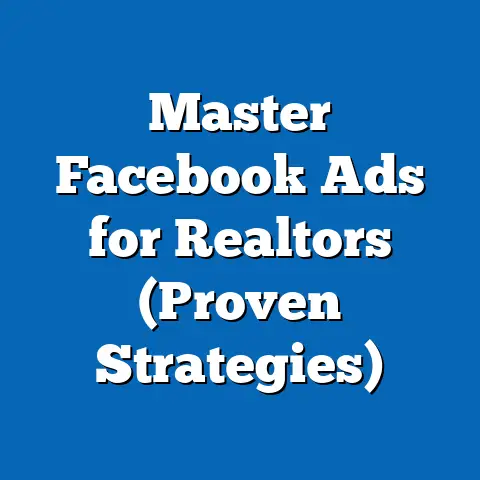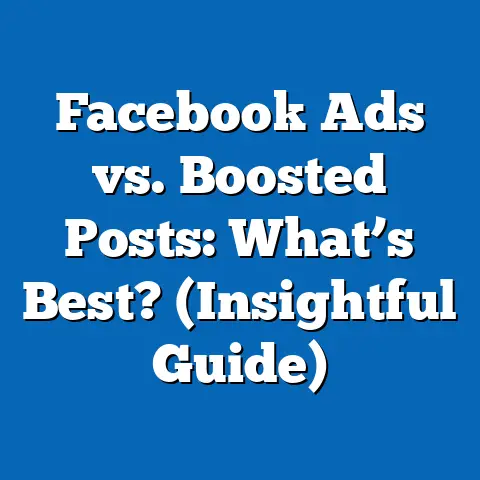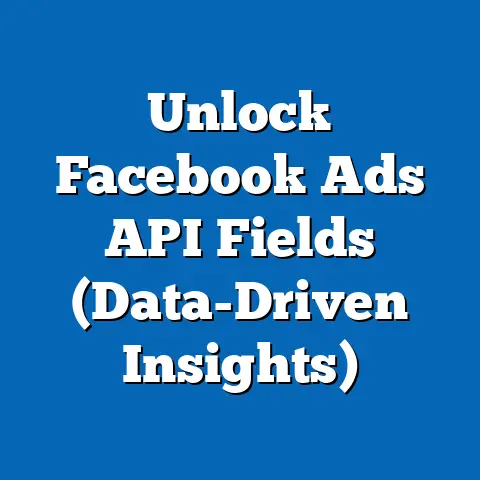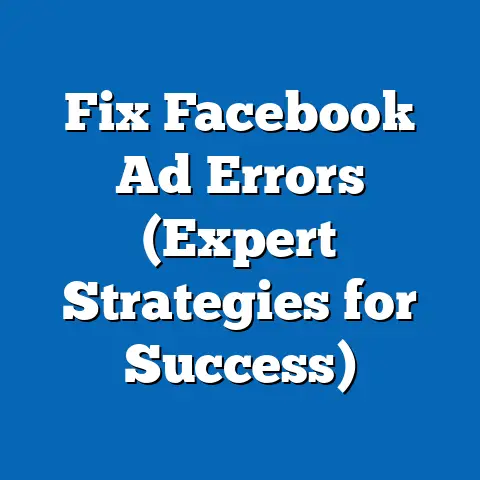Master Carousel Ads for Facebook (Expert Best Practices)
In the ever-evolving digital marketing landscape, every dollar I spend on advertising needs to work hard. It’s not just about getting your name out there; it’s about driving measurable results, building brand loyalty, and ultimately, increasing sales. That’s where Facebook Carousel Ads come in. I’ve seen firsthand how this ad format, with its unique ability to showcase multiple products or tell a captivating story through a series of images or videos, can significantly enhance engagement and conversion rates.
Imagine giving your audience a curated, immersive experience right within their Facebook feed. That’s the power of Carousel Ads. But let’s be clear: mastering this format isn’t just about slapping together some pretty pictures. It’s about strategic planning, meticulous execution, and a deep understanding of your target audience. This guide is designed to equip you with the knowledge and best practices to transform your Carousel Ads from a cost center into a powerful engine for growth. Let’s dive in!
Understanding Carousel Ads
So, what exactly are Carousel Ads? Simply put, they are an ad format on Facebook that allows you to display up to ten images or videos, each with its own headline, description, link, and call-to-action. Think of it as a mini-website experience right within the Facebook newsfeed. Users can swipe through the different cards, exploring your offerings in a visually engaging way.
These ads are composed of several key elements:
- Images or Videos: The visual component of each card, showcasing your product, service, or message.
- Headline: A short, attention-grabbing title for each card.
- Description: A brief explanation or benefit statement accompanying the visual.
- Link: The URL where you want to direct users who click on the card.
- Call-to-Action (CTA): A button that prompts users to take a specific action, such as “Shop Now,” “Learn More,” or “Sign Up.”
The versatility of Carousel Ads is one of their biggest strengths. You can use them to:
- Showcase a range of products: Ideal for e-commerce businesses looking to highlight multiple items in their inventory.
- Tell a story: Perfect for building brand awareness and connecting with your audience on an emotional level.
- Explain a process: Great for demonstrating how your product or service works.
- Highlight different features of a single product: Effective for showcasing the value proposition of a particular item.
Don’t just take my word for it. Studies have shown that Carousel Ads can achieve significantly higher click-through rates (CTR) and conversion rates compared to single-image or video ads. In fact, Facebook themselves has reported that carousel ads can drive 10x more traffic to websites. This is because they offer a more engaging and informative experience, capturing users’ attention and encouraging them to take action.
Takeaway: Carousel Ads are a dynamic and versatile ad format that can significantly enhance your Facebook advertising efforts. Understanding their components and potential uses is the first step to mastering them.
Key Benefits of Using Carousel Ads
I’ve already touched upon the potential benefits of Carousel Ads, but let’s delve deeper into why they’re such a powerful tool for businesses.
- Higher Engagement Rates: The interactive nature of Carousel Ads keeps users engaged for longer. The ability to swipe through multiple cards encourages them to explore your offerings and learn more about your brand.
- Improved Click-Through Rates (CTR): The multiple calls to action and diverse content within a Carousel Ad can lead to a higher CTR compared to traditional ad formats. Users are more likely to find something that resonates with them and click through to your website.
- More Information in a Single Ad: Unlike single-image or video ads, Carousel Ads allow you to provide a wealth of information in a single ad unit. This can be particularly useful for showcasing complex products or services.
- Cater to Different Marketing Objectives: Whether you’re aiming to boost brand awareness, generate leads, or drive sales, Carousel Ads can be tailored to meet your specific goals. You can customize the visuals, copy, and calls to action to align with your objectives.
- Enhanced User Experience: The swiping motion and visual format make Carousel Ads a more enjoyable and intuitive experience for users. This can lead to a more positive perception of your brand and a greater likelihood of conversion.
I remember working with a client who sold online courses. Initially, they were running single-image ads promoting individual courses. While they saw some results, the engagement was lackluster. We decided to switch to Carousel Ads, showcasing a variety of courses and highlighting the benefits of each. The results were remarkable. We saw a significant increase in both CTR and conversions, proving that the ability to showcase multiple options in a single ad was a game-changer.
Takeaway: Carousel Ads offer a multitude of benefits, from higher engagement and CTR to the ability to cater to different marketing objectives and enhance the user experience.
Best Practices for Creating Effective Carousel Ads
Now, let’s get into the nitty-gritty of creating Carousel Ads that truly deliver results. I’ve learned these best practices through years of experience and countless A/B tests.
Crafting Compelling Visuals
Visuals are the cornerstone of any successful Carousel Ad. High-quality images and videos are essential for capturing attention and conveying your message effectively.
- High-Resolution Images: Use images that are crisp, clear, and visually appealing. Avoid blurry or pixelated images, as they can detract from the overall impression.
- Professional-Quality Videos: If you’re using videos, ensure they are well-produced and engaging. Invest in good lighting, sound, and editing to create a polished final product.
- Brand Alignment: Your visuals should be consistent with your brand identity, using your brand colors, fonts, and style. This helps to reinforce brand recognition and create a cohesive experience.
- Eye-Catching Design: Use creative design elements to make your visuals stand out. Consider adding text overlays, graphics, or animations to capture attention.
I once worked with a clothing retailer whose Carousel Ads featured low-quality product photos. The clothing itself was stylish, but the poorly lit, unflattering images were turning potential customers away. We invested in professional product photography, and the difference was night and day. The improved visuals led to a significant increase in sales, demonstrating the power of high-quality imagery.
Strategic Storytelling
The Carousel format is perfect for telling a story or showcasing a product journey. By arranging your cards in a logical order, you can guide users through a narrative that builds interest and encourages them to take action.
- Define Your Story: Before you start creating your Carousel Ad, determine the story you want to tell. What message do you want to convey? What action do you want users to take?
- Logical Order: Arrange your cards in a sequence that makes sense and builds upon each other. Start with an attention-grabbing opening card and end with a strong call to action.
- Consistent Theme: Maintain a consistent theme throughout your Carousel Ad to create a cohesive and engaging experience.
- Showcase Benefits: Highlight the benefits of your product or service in each card, emphasizing how it can solve a problem or improve the user’s life.
For example, a travel agency could use a Carousel Ad to tell the story of a dream vacation. The first card could feature a stunning image of the destination, followed by cards showcasing the different activities and attractions available. The final card could include a call to action to book the trip.
Optimizing for Mobile
Given that the vast majority of Facebook users access the platform via mobile devices, mobile optimization is crucial for Carousel Ad success.
- Mobile-Friendly Visuals: Ensure your images and videos are optimized for mobile viewing. Use a size that is easily viewed, and don’t include too much text on the image itself.
- Clear and Concise Copy: Keep your copy short and to the point, as users on mobile devices are often scrolling quickly and have limited attention spans.
- Fast Loading Times: Optimize your visuals for fast loading times to avoid frustrating users who may be on slow internet connections.
- Easy Navigation: Make sure the swiping motion is smooth and intuitive, allowing users to easily navigate through your Carousel Ad.
I always recommend testing your Carousel Ads on different mobile devices to ensure they look and perform as expected.
Effective Copywriting
The copy in your Carousel Ads plays a crucial role in capturing attention, conveying your message, and encouraging users to take action.
- Succinct and Compelling: Write copy that is clear, concise, and attention-grabbing. Use strong verbs and persuasive language to pique users’ interest.
- Highlight Benefits: Focus on the benefits of your product or service, emphasizing how it can solve a problem or improve the user’s life.
- Strong Calls to Action (CTAs): Include clear and compelling CTAs on each card, telling users exactly what you want them to do. Use action-oriented language, such as “Shop Now,” “Learn More,” or “Sign Up.”
- A/B Testing: Test different variations of your copy to see what resonates best with your target audience. Experiment with different headlines, descriptions, and CTAs to optimize your results.
I’ve found that using numbers and statistics in your copy can be very effective. For example, instead of saying “Our product is effective,” you could say “Our product has been proven to increase sales by 20%.”
Testing and Iteration
A/B testing is essential for optimizing your Carousel Ads and maximizing your ROI. By testing different variations of your ads, you can identify what resonates best with your target audience and refine your strategy accordingly.
- Test Different Visuals: Experiment with different images and videos to see which ones capture the most attention.
- Test Different Copy: Try different headlines, descriptions, and CTAs to see which ones drive the most clicks and conversions.
- Test Different Targeting Options: Explore different audience segments to see which ones are most responsive to your Carousel Ads.
- Track Performance: Use Facebook’s analytics tools to track the performance of your Carousel Ads and identify areas for improvement.
- Iterate Based on Data: Use the data you collect to make informed decisions about how to optimize your Carousel Ads. Continuously iterate and refine your strategy based on what you learn.
I recommend starting with a few key variables and testing them one at a time. This will help you isolate the impact of each variable and make more informed decisions.
Takeaway: Creating effective Carousel Ads requires a combination of compelling visuals, strategic storytelling, mobile optimization, effective copywriting, and rigorous testing and iteration.
Advanced Strategies for Carousel Ads
Once you’ve mastered the basics of Carousel Ads, you can start exploring more advanced strategies to take your campaigns to the next level.
- Retargeting: Use Carousel Ads to re-engage users who have previously interacted with your website or app. Show them products they viewed but didn’t purchase, or offer them a special discount to incentivize them to convert.
- Dynamic Product Ads: Automate the process of showcasing products based on user behavior. Facebook will automatically display relevant products to users based on their browsing history and interests.
- Sequential Storytelling: Create a narrative that evolves over time, using Carousel Ads to tell a multi-part story that keeps users engaged.
- Audience Segmentation: Tailor your Carousel Ads to specific audience segments based on their demographics, interests, and behaviors. This will help you create more relevant and engaging ads that resonate with your target audience.
I’ve seen incredible results with dynamic product ads. By automating the process of showcasing relevant products to users, we were able to significantly increase sales and improve ROI for several e-commerce clients.
Takeaway: Advanced Carousel Ad strategies like retargeting, dynamic product ads, sequential storytelling, and audience segmentation can help you take your campaigns to the next level.
Case Studies and Success Stories
Let’s take a look at some real-world examples of brands that have effectively utilized Carousel Ads.
- Sephora: The beauty retailer used Carousel Ads to showcase different makeup looks, with each card featuring a different product and a link to purchase it. This campaign resulted in a significant increase in sales and brand awareness.
- Airbnb: The travel platform used Carousel Ads to highlight different vacation rentals, with each card featuring a stunning image of the property and a link to book it. This campaign drove a significant increase in bookings.
- Warby Parker: The eyewear company used Carousel Ads to showcase different styles of glasses, with each card featuring a different frame and a link to try it on virtually. This campaign helped to increase brand awareness and drive sales.
These successful campaigns share a few key characteristics:
- Compelling Visuals: All of the ads featured high-quality, visually appealing images.
- Strategic Storytelling: The ads told a clear and engaging story.
- Clear Calls to Action: The ads included clear and compelling CTAs.
- Targeted Audience: The ads were targeted to relevant audience segments.
Takeaway: Learning from successful Carousel Ad campaigns can help you identify best practices and apply them to your own strategy.
Conclusion
Carousel Ads are a powerful tool that, in my experience, can deliver significant results for businesses of all sizes. By embracing the best practices outlined in this article, you can maximize your advertising ROI and drive substantial business growth. Remember, it’s not just about creating pretty pictures; it’s about strategic planning, meticulous execution, and a deep understanding of your target audience. With the right approach, Carousel Ads can transform your marketing campaigns from a cost center into a powerful engine for growth. So, go out there, experiment, and see what Carousel Ads can do for your business!





